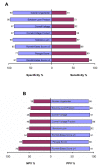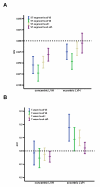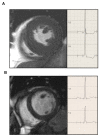Electrocardiographic diagnosis of left ventricular hypertrophy in aortic valve disease: evaluation of ECG criteria by cardiovascular magnetic resonance
- PMID: 19486532
- PMCID: PMC2696426
- DOI: 10.1186/1532-429X-11-18
Electrocardiographic diagnosis of left ventricular hypertrophy in aortic valve disease: evaluation of ECG criteria by cardiovascular magnetic resonance
Abstract
Background: Left ventricular hypertrophy (LVH) is a hallmark of chronic pressure or volume overload of the left ventricle and is associated with risk of cardiovascular morbidity and mortality. The purpose was to evaluate different electrocardiographic criteria for LVH as determined by cardiovascular magnetic resonance (CMR). Additionally, the effects of concentric and eccentric LVH on depolarization and repolarization were assessed.
Methods: 120 patients with aortic valve disease and 30 healthy volunteers were analysed. As ECG criteria for LVH, we assessed the Sokolow-Lyon voltage/product, Gubner-Ungerleider voltage, Cornell voltage/product, Perugia-score and Romhilt-Estes score.
Results: All ECG criteria demonstrated a significant correlation with LV mass and chamber size. The highest predictive values were achieved by the Romhilt-Estes score 4 points with a sensitivity of 86% and specificity of 81%. There was no difference in all ECG criteria between concentric and eccentric LVH. However, the intrinsicoid deflection (V6 37 +/- 1.0 ms vs. 43 +/- 1.6 ms, p < 0.05) was shorter in concentric LVH than in eccentric LVH and amplitudes of ST-segment (V5 -0.06 +/- 0.01 vs. -0.02 +/- 0.01) and T-wave (V5 -0.03 +/- 0.04 vs. 0.18 +/- 0.05) in the anterolateral leads (p < 0.05) were deeper.
Conclusion: By calibration with CMR, a wide range of predictive values was found for the various ECG criteria for LVH with the most favourable results for the Romhilt-Estes score. As electrocardiographic correlate for concentric LVH as compared with eccentric LVH, a shorter intrinsicoid deflection and a significant ST-segment and T-wave depression in the anterolateral leads was noted.
Figures




References
-
- Gübner R, Ungerleider H. Electrocardiographic criteria of left ventricular hypertrophy. Arch Intern Med. 1943. pp. 831–836.
-
- Pentti M, Rautaharju TAM, David Siscovick, Sophia H Zhou, Julius M Gardin, Curt D Furberg, Nemat O Borhani, Anne Newman. Classification Accuracy of Electrocardiographic Criteria for Left Ventricular Hypertrophy in Normal Weight and Overweight Older Adults. Annals of Noninvasive Electrocardiology. 1996;1:121–132. doi: 10.1111/j.1542-474X.1996.tb00271.x. - DOI
Publication types
MeSH terms
LinkOut - more resources
Full Text Sources
Medical
Research Materials

